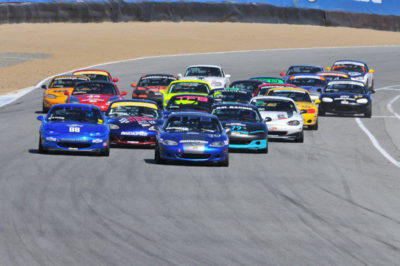TO: Spec Miata Participants
FR: SCCA, NASA, Mazda Motorsports, and the Spec Miata Working Group
RE: Class Intent, Direction and Regulations
DT: December 19, 2014
Mazda, SCCA, and NASA wish to thank the hundreds of SM drivers and owners who have provided their helpful feedback. With it, we have been able to investigate and reflect on the current status of the class and its future direction. We were able to provide these data points to the SCCA’s Board of Directors, which as many of you know, has just passed a rule clarification to Rule GCR 9.1.7.C.1.f.3 regarding cylinder heads. Coupled with this rule clarification, which Mazda believes is in the best interest of the Spec Miata community, the BoD also approved rule 5.11.4 to allow the Club Racing department to designate a Class Compliance Chief; both rules are outlined below. However, Mazda, NASA, and the SCCA still have work to do.
During our last unified memorandum to the Spec Miata Community, we outlined our next steps. Among these, the SM Working Group, comprised of industry experts, would determine the performance differences between stock cylinder heads, plunge cut heads (with and without de-burring), and non-compliant heads for the 1.6L and 1.8L engines, using dyno testing; this comprehensive process is still underway.
For those waiting to make decisions for the 2015 season, we strongly encourage you to read the two rules passed this week by SCCA’s board. For those previously compliant and for those with acceptable levels of de-burring, as outlined in the new rule, the path is paved and we are excited for you to compete in a class that will have even more parity. This new rule allowing for de-burring is the current and future direction. The on-going dyno testing results will not affect or alter this rule. For those outside this acceptable range, it is recommended that you make the necessary corrections. While weight adjustments have been considered to allow for those non-compliant to continue to compete, albeit at a punitive level, it is NOT the current direction.
All of these acts –the decision to permit plunge cuts with the acceptable levels of de-burring outlined, the introduction of the Class Compliance Chief, and the dyno testing to determine performance differences –will help achieve the overall Spec Miata class goal: To provide the membership with the opportunity to compete in low-cost, production-based cars with limited modifications, suitable for racing competition.
As always, we are thankful for your support and faith in us to make the best decisions for the class based on all these data points.
Rule GCR 9.1.7.C.1.f.3, regarding cylinder heads, now reads: “The throat area of the port consists of the 90 degree angle at the very bottom of the cast steel valve seat as it transitions to the aluminum casting below. It is permitted to plunge cut the throats in order to correct for core shift that is commonly found in many cylinder heads. The cut must be cylindrical and concentric to the valve guide axial centerline, within a tolerance of .005”, for the entire length of the cut. The radius tangent to the cylindrical and bottom surfaces shall not exceed 0.375“. This cut cannot extend further than the specified number below from the bottom of the ferrous valve seat. There can be no tooling or machine marks in the head below this point. The Intersection of the machined surface of the plunge cut to the port casting shall not be altered, except that the area under the short turn radius may be de-burred, with the de-burring not to exceed 1.5 mm in width. The 90 degree bend at the bottom of the valve seat and the aluminum directly below it will be measured with a gauge and must conform to the maximum diameters and depths listed below.”
The rule 5.11.4 states: “When assigned to an event by the head of Club Racing or his designate, the CCC works with the event technical staff to provide consistent compliance checking across all the events in designated class/es. Decisions made by the CCC regarding compliance are non-protestable.”


 ACCESSIBILITY
ACCESSIBILITY